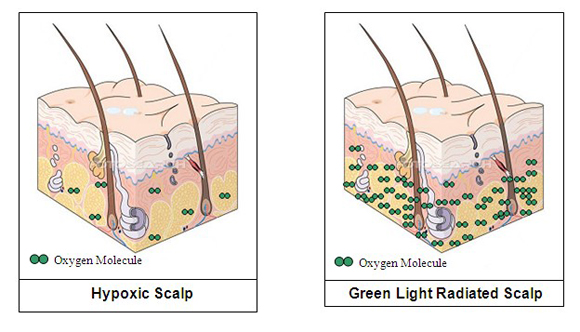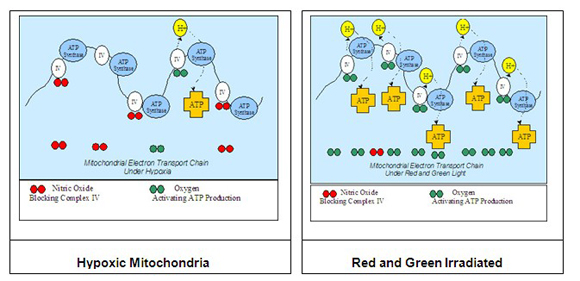Low Level Light Therapy System
Photo Regeneration of Scalp Tissue and Hair Regrowth
Click Here to Download a PDF Brochure.The simultaneous applications of both green and red light can revitalize scalp tissue by increasing the amount of oxygen in the tissue and stimulating the production of cellular energy.
Hair Loss and Hypoxia
It has been demonstrated that oxygen deficiency (hypoxia) exists in balding scalp, and that the microvasculature around the follicle in balding areas is deficient compared to the microvasculature around follicles with normal hair growth. Oxygen starvation leads to limited hair growth and compromised cellular repair mechanisms. It is believed by many that local tissue hypoxia may be the underlying pathophysiology by which age, genetics, and androgens interact to cause baldness.1
The effects of DHT in male pattern baldness are related to the microvasculature deficiencies. The increase in androgen (DHT) production in the scalp area inhibits mitosis, and induces insulin sensitivity in the follicular area. This insulin resistance further induces vasoactive substances that cause microvascular insufficiency and local tissue hypoxia with progressive miniaturization of hair follicles.2 Once the oxygen starvation is initiated by DHT, the energy production within the cells in the hypoxic area is also shut down. Under hypoxic conditions the mitochondria shut down as a survival mechanism.3
Hair regrowth requires that we overcome the hypoxia caused by excessive androgen production, and the purpose of the red and green light is to reoxygenate the tissue and reinvigorate the mitochondria so energy production can resume.
Hypoxia and Red Light
The use of red light from LED and laser sources has been demonstrated to increase hair regrowth. Red light is effective for hair regrowth because it can stimulate ATP production.4
Under hypoxic conditions the walls of the mitochondria are signaled to produce a diatomic gas molecule called nitric oxide. This nitric oxide acts as a "governor" or speed control for ATP production. The nitric oxide molecule can position itself on the electron transport chain complex normally reserved for molecular oxygen. Nitric oxide is a competitive inhibitor of oxygen for ATP production and no energy production takes place.5 & 6
Red light interacts with the nitric oxide-enzyme IV complex to photodissociate or eject the nitric oxide molecule and this makes the position open for an oxygen molecule. When the oxygen molecule replaces the nitric oxide, energy production is back in place and ATP production begins. Of course oxygen must be available to replace the ejected nitric oxide molecule. We know that red light can clear the way for ATP production to proceed, but we also need fresh oxygen in the area to complete the reaction. This is the purpose of green light as discuss next.
Green Light and Hypoxia
Increasing the oxygen availability to tissue can be accomplished by vasodilators but also by tapping into the large reservoir of oxygen carried by the blood in the papillary dermis. Green light at 550 nm (the middle of the Q-band hemoglobin absorption) has been demonstrated to photodissociate molecular oxygen from oxyhemoglobin, and this freed oxygen is available to prefuse tissues even where the vasculature is deficient.7
The advantage of the 550 nm radiation is that it is absorbed 35 times more than red light at 615 nm and 150 times more than red laser radiation at 670 nm. Green light has greater quantum efficiency for photodissociation of oxygen than red light, and the probability of its absorption by hemoglobin is also much higher. The photodissociation of oxyhemoglobin into oxygen and hemoglobin can be spectacularly efficient. A 65% quantum efficiency at 550 nm has been reported, although the original oxygen-releasing hemoglobin molecule recaptures much of the released oxygen.8
The effects of green light are illustrated below for both the scalp matrix and the mitochondrial ATP production.


Complementary actions of Red and Green Light.
The ability of green light to increase PO2 in hypoxic tissue has been recognized for application in photodynamic therapy where extreme ROS production causes hypoxia. In the case of hypoxic scalp we can see the benefits of red and green light mimic the activities of Minoxidil in that there is tissue reoxygenation provided by the green light (similar to the vasodilation effects of Minoxidil) and the red light provides increased ATP production by removing nitric oxide from the electron transport chain (Minoxidil increases ATP production by shifting calcium ions to make the hydrogen ion potential appear higher).
The advantages of using light for reoxygenation and stimulation of new energy production is that there are no chemical side effects and the energy produced can be stored for longer-term needs. Essentially when used with an ongoing program of topical vasodilators, anti-androgenics and antioxidants the light therapy provides a bolus therapy for tissue regeneration. The energy producing effects from a 5-minute procedure will continue for hours after the procedure, and this will build up large stores of ATP for tissue and vascular regeneration. The light therapy is to provide for a powerful source of energy for remodeling the scalp, and the ongoing topical therapies will allow for continued growth.
Topical applications of KATP vasodilators like Minoxidil can slowly but reliably move the hypoxic tissue from energy insufficiency and help balance the deleterious hypoxic effects caused by excess DHT activity. However the addition of light treatments boosts and complements the activity of these agents and provides a strong platform for scalp remodeling.
Optimal Treatment Regimens
The optimal use of Red and Green light treatments is patient specific; in general the longer the hair loss condition has been established the more treatment will be required to see results. Daily treatments for the first week would give the quickest regeneration of the mitochondrial ATP functions, but 3 Tx/week will give good results. After six light treatments the optimal treatment regimen is 2 Tx/week for and additional six treatments. There is no downside to continuing the treatments.
1. Goldman BE, Fisher DM, Ringler SL., Transcutaneous PO2 of the scalp in male pattern baldness: a new piece to the puzzle., Plast Reconstr Surg. 1996 May;97(6):1109-16; discussion 1117.
2. Matilainen VA, Keinanen-Kiukaanniemi SM., Hormone-induced aberrations in electromagnetic adhesion signaling as a developmental factor of androgenetic alopecia. Med Hypotheses. 2002 Apr;58(4):261-3.
3. Kristin Heerlein, Andreas Schulze, Lorenz Hotz, Peter Bartsch and Heimo Mairbaurl, Hypoxia Decreases Cellular ATP Demand and Inhibits Mitochondrial Respiration of A549 Cells, American Journal of Respiratory Cell and Molecular Biology. Vol. 32, pp. 44-51, 2005.
4. Benedicenti S, Pepe IM, Angiero F, Benedicenti A., Intracellular ATP level increases in lymphocytes irradiated with infrared laser light of wavelength 904 nm , Photomed Laser Surg. 2008 Oct;26(5):451-3.
5. Weiming Xu, Ian G. Charles, Salvador Moncada, Nitric Oxide: Orchestrating hypoxia through mitochondrial respiration and the endoplasmic reticulum stress response. Cell Research, 15(1):63-65, Jan. 2005
6. Guy C. Brown, Nitric oxide inhibition of cytochrome oxidase and mitochondrial respiration: Implications for inflammatory neurodegenerative and ischemic pathologies, Molecular and Cellular Biochemistry, Vol. 174, Numbers 1-2: 189-192, Sept., 1997
7. Asimov, Mustafo M, Asimov, Rustam M, Mirshahi, M., Effect of laser-induced photodissociation of oxyhemoglobin on biomedical processes, Proc. SPIE, Vol. 4397, 390 (2001); DOI:10.1117/12.425172
8. Valat, P., Alpert, B. , Quantum Yield of Thirty Picosecond Oxyhemoglobin Photodissociation. Effect of Protein Fluctuations on the Quantum Yield Values, Laser Chem. 1985, Vol. 5, pp. 173-183 0278-6273/85/0504-0173512.00/0.
Why Choose NeoGraft
- No linear scar
- No Sutures or Staples
- No Long Recovery Time
- Back to work & play in half the time
- Able to do small or large number of grafts
- Less expensive than traditional FUE








